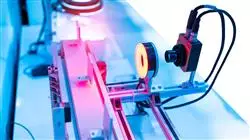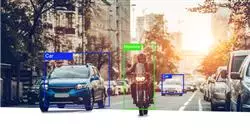University certificate
The world's largest faculty of information technology”
Introduction to the Program
Learn about the most advanced computer vision techniques thanks to this Postgraduate diploma, which prepares you to successfully face all future challenges in the field of machine vision"

Computer vision is a complex and expanding field that is constantly adding new applications and utilities. Therefore, in order to get the most out of computer vision tools, it is important to master the most advanced and innovative techniques in this area. Accordingly, this Postgraduate diploma in Advanced Web-Based Computer Vision Techniques responds to this challenge, providing the professional with the most recent procedural and technological advances in this field.
In this program, therefore, computer scientists will be able to study aspects such as 2D image depth maps, depth measurement, 3D object recognition, semantic segmentation in medicine or point cloud segmentation, among many others, in depth. In this way, the engineer will have been able to access numerous new and high-level contents in this area.
And this will be achieved thanks to a specialized and very experienced teaching staff that knows all the keys to the discipline, in addition to the large number of multimedia resources available in this program, such as interactive summaries, practical exercises, master classes or videos of techniques and procedures.
Learn about new computer vision procedures and incorporate them into your work immediately with this educational program"
This Postgraduate diploma in Advanced Web-Based Computer Vision Techniques contains the most complete and up-to-date program on the market. The most important features include:
- The development of case studies presented by experts in computer science and computer vision
- The graphic, schematic, and practical contents with which they are created, provide scientific and practical information on the disciplines that are essential for professional practice
- Practical exercises where the self-assessment process can be carried out to improve learning
- Its special emphasis on innovative methodologies
- Theoretical lessons, questions to the expert, debate forums on controversial topics, and individual reflection assignments
- Content that is accessible from any fixed or portable device with an Internet connection
Develop great computer vision projects thanks to everything you will learn in this Postgraduate diploma"
The program’s teaching staff includes professionals from sector who contribute their work experience to this program, as well as renowned specialists from leading societies and prestigious universities.
The multimedia content, developed with the latest educational technology, will provide the professional with situated and contextual learning, i.e., a simulated environment that will provide immersive education programmed to learn in real situations.
This program is designed around Problem-Based Learning, whereby the professional must try to solve the different professional practice situations that arise during the academic year. For this purpose, the student will be assisted by an innovative interactive video system created by renowned and experienced experts.
Your mastery of computer vision will give you access to numerous career opportunities in the best technology companies in the world"

You are looking for a program that will set you apart professionally and this is the perfect one for you, as it will allow you to become a computer vision specialist"
Why study at TECH?
TECH is the world’s largest online university. With an impressive catalog of more than 14,000 university programs available in 11 languages, it is positioned as a leader in employability, with a 99% job placement rate. In addition, it relies on an enormous faculty of more than 6,000 professors of the highest international renown.

Study at the world's largest online university and guarantee your professional success. The future starts at TECH”
The world’s best online university according to FORBES
The prestigious Forbes magazine, specialized in business and finance, has highlighted TECH as “the world's best online university” This is what they have recently stated in an article in their digital edition in which they echo the success story of this institution, “thanks to the academic offer it provides, the selection of its teaching staff, and an innovative learning method aimed at educating the professionals of the future”
A revolutionary study method, a cutting-edge faculty and a practical focus: the key to TECH's success.
The most complete study plans on the university scene
TECH offers the most complete study plans on the university scene, with syllabuses that cover fundamental concepts and, at the same time, the main scientific advances in their specific scientific areas. In addition, these programs are continuously being updated to guarantee students the academic vanguard and the most in-demand professional skills. In this way, the university's qualifications provide its graduates with a significant advantage to propel their careers to success.
TECH offers the most comprehensive and intensive study plans on the current university scene.
A world-class teaching staff
TECH's teaching staff is made up of more than 6,000 professors with the highest international recognition. Professors, researchers and top executives of multinational companies, including Isaiah Covington, performance coach of the Boston Celtics; Magda Romanska, principal investigator at Harvard MetaLAB; Ignacio Wistumba, chairman of the department of translational molecular pathology at MD Anderson Cancer Center; and D.W. Pine, creative director of TIME magazine, among others.
Internationally renowned experts, specialized in different branches of Health, Technology, Communication and Business, form part of the TECH faculty.
A unique learning method
TECH is the first university to use Relearning in all its programs. It is the best online learning methodology, accredited with international teaching quality certifications, provided by prestigious educational agencies. In addition, this disruptive educational model is complemented with the “Case Method”, thereby setting up a unique online teaching strategy. Innovative teaching resources are also implemented, including detailed videos, infographics and interactive summaries.
TECH combines Relearning and the Case Method in all its university programs to guarantee excellent theoretical and practical learning, studying whenever and wherever you want.
The world's largest online university
TECH is the world’s largest online university. We are the largest educational institution, with the best and widest online educational catalog, one hundred percent online and covering the vast majority of areas of knowledge. We offer a large selection of our own degrees and accredited online undergraduate and postgraduate degrees. In total, more than 14,000 university degrees, in eleven different languages, make us the largest educational largest in the world.
TECH has the world's most extensive catalog of academic and official programs, available in more than 11 languages.
Google Premier Partner
The American technology giant has awarded TECH the Google Google Premier Partner badge. This award, which is only available to 3% of the world's companies, highlights the efficient, flexible and tailored experience that this university provides to students. The recognition as a Google Premier Partner not only accredits the maximum rigor, performance and investment in TECH's digital infrastructures, but also places this university as one of the world's leading technology companies.
Google has positioned TECH in the top 3% of the world's most important technology companies by awarding it its Google Premier Partner badge.
The official online university of the NBA
TECH is the official online university of the NBA. Thanks to our agreement with the biggest league in basketball, we offer our students exclusive university programs, as well as a wide variety of educational resources focused on the business of the league and other areas of the sports industry. Each program is made up of a uniquely designed syllabus and features exceptional guest hosts: professionals with a distinguished sports background who will offer their expertise on the most relevant topics.
TECH has been selected by the NBA, the world's top basketball league, as its official online university.
The top-rated university by its students
Students have positioned TECH as the world's top-rated university on the main review websites, with a highest rating of 4.9 out of 5, obtained from more than 1,000 reviews. These results consolidate TECH as the benchmark university institution at an international level, reflecting the excellence and positive impact of its educational model.” reflecting the excellence and positive impact of its educational model.”
TECH is the world’s top-rated university by its students.
Leaders in employability
TECH has managed to become the leading university in employability. 99% of its students obtain jobs in the academic field they have studied, within one year of completing any of the university's programs. A similar number achieve immediate career enhancement. All this thanks to a study methodology that bases its effectiveness on the acquisition of practical skills, which are absolutely necessary for professional development.
99% of TECH graduates find a job within a year of completing their studies.
Postgraduate Diploma in Advanced Web Based Computer Vision Techniques
.
Dive into the exciting field of web computer vision with our Postgraduate Diploma in Advanced Web Based Computer Vision Techniquesprogram at TECH Global University. Through our online classes, we offer you the opportunity to acquire specialized skills in image processing and visual recognition, boosting your career in the digital world. By opting for our online classes, you will enjoy significant benefits. You will be able to access course content 24 hours a day, 7 days a week, giving you the flexibility to learn at your own pace.
Boost your Career in the Digital World
.
In today's era, computer vision has become a core discipline in various industries, such as artificial intelligence, robotics and augmented reality. Our program will provide you with the knowledge and techniques needed to develop innovative web applications that interact with images and videos in real time. You will explore advanced topics such as image processing, visual content analysis, object recognition and motion tracking. You will learn how to use computer vision algorithms and libraries to extract valuable information from images and perform analysis and classification tasks. Online classes are a great advantage of our program, as they allow you to access your education from anywhere in the world. In addition, you will be able to adapt your study schedule to your needs, without sacrificing the quality of the teaching. You will be able to interact with professors who are experts in the field and collaborate with other students, enriching your educational experience. Our program will give you the opportunity to work on hands-on projects, where you will apply your knowledge in real-life situations. You will gain hands-on experience and develop a strong portfolio that will set you apart in the job market. Boost your career in the digital world and acquire advanced skills in web computer vision. Enroll in our Postgraduate Diploma in Advanced Web Computer Vision Techniques at TECH Global University and open the doors to exciting career opportunities!







